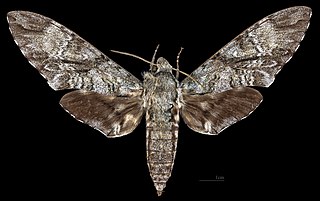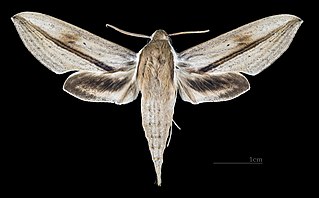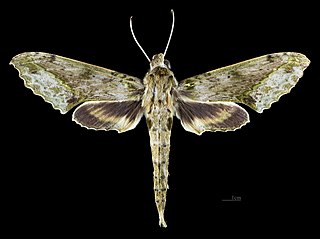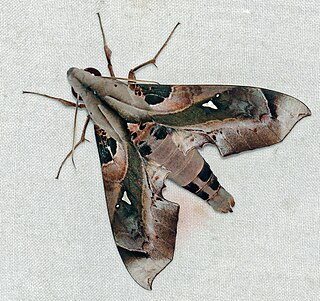
Cocytius lucifer is a moth of the family Sphingidae first described by Walter Rothschild and Karl Jordan in 1903.

Aellopos ceculus is a moth of the family Sphingidae.

Eumorpha capronnieri is a moth of the family Sphingidae first described by Jean Baptiste Boisduval in 1875.

Eumorpha elisa is a moth of the family Sphingidae.

Eumorpha phorbas is a moth of the family Sphingidae.

Eumorpha triangulum is a moth of the family Sphingidae.

Eumorpha vitis, known as the vine sphinx, is a moth of the family Sphingidae.

Manduca barnesi is a moth of the family Sphingidae.

Xylophanes germen is a moth of the family Sphingidae. It is known from Mexico, Costa Rica, Guatemala and is found from Venezuela to Bolivia.

Xylophanes turbata is a moth of the family Sphingidae. It is known from Mexico to Nicaragua and Costa Rica. An occasional stray may be found up to southern Arizona.

Xylophanes undata is a moth of the family Sphingidae.

Eupyrrhoglossum sagra, the Cuban sphinx, is a moth of the family Sphingidae. The species was first described by Felipe Poey in 1832. It is known from tropical and subtropical lowlands in Cuba and from Mexico and Belize to Guatemala, Costa Rica, Bolivia, Paraguay, Argentina and Uruguay. Occasionally, strays are found in Florida.

Eumorpha adamsi is a species of moth in the family Sphingidae. It was described by Walter Rothschild and Karl Jordan, in 1903, and is known from Venezuela, Brazil, Bolivia and Paraguay but is probably present throughout most of South America.

Madoryx plutonius is a moth of the family Sphingidae.

Nyceryx coffaeae is a moth of the family Sphingidae. It is found from Mexico, Belize, Guatemala and Costa Rica into South America, where it is known from Brazil, Colombia, Ecuador and Bolivia.

Nyceryx magna is a moth of the family Sphingidae.

Eumorpha analis is a moth of the family Sphingidae.

Eumorpha cissi is a moth of the family Sphingidae.

Eumorpha obliquus is a moth of the family Sphingidae. It is found from Belize, Guatemala, Nicaragua and Costa Rica south to Bolivia. It is also present in Brazil and Guadeloupe.

Eumorpha translineatus is a moth of the family Sphingidae.























